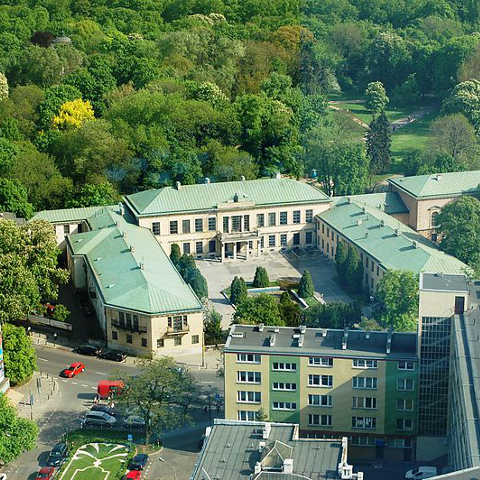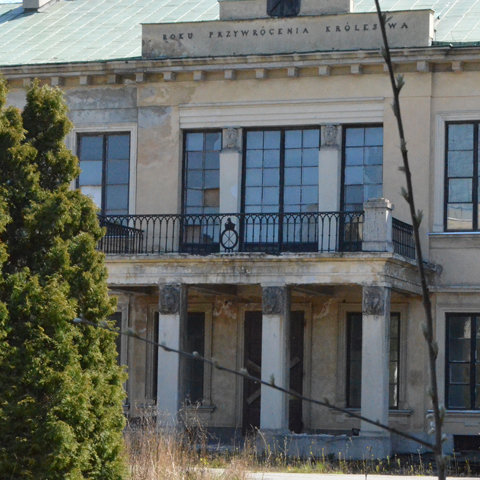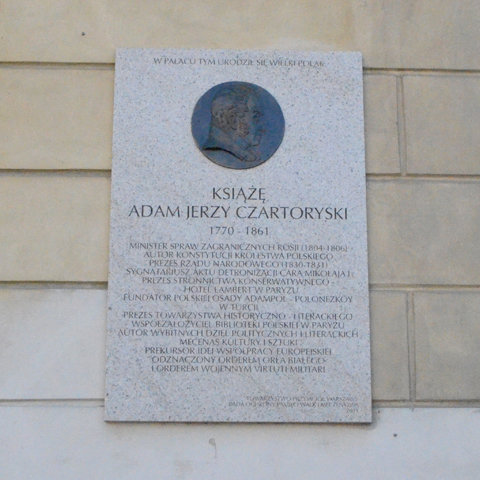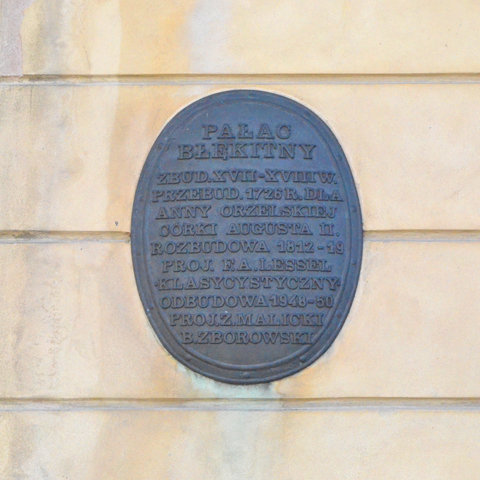Composers / Fryderyk Chopin / Places catalog
Blue Palace
In 1726, King Augustus II the Strong ordered a beautiful rococo palace to be erected on the site of the former residence of Teodor Potocki, Bishop of Chełmno, on the edge of the Saxon Gardens. The palace was a Christmas present for Anna Orzelska, his recently discovered illegitimate daughter, and had to be completed in a couple of months. Orzelska, whose beauty was celebrated all over Warsaw, was apparently particularly fond of blue. Hence the characteristic blue [Polish: “błękitny”] roof from which the palace derives its name. After her wedding to Duke Charles Louis of Schleswig-Holstein-Sonderburg-Beck, a few years later, the palace came into the hands of the Czartoryski family, and in August 1811 the principal heir to the Zamoyski estate, Stanisław Kostka Zamoyski, purchased it from his father-in-law, Adam Czartoryski.
Stanisław Kostka Zamoyski married Zofia Czartoryska, who was renowned for her beauty, accomplishments and superb taste. As Andrzej Edward Koźmian recalled, with something approaching tenderness, ‘the harmony of all the virtues and qualities of Lady Zamoyska created a whole so perfect that she could safely have been called a living masterpiece… Many a beauty delighted in more regular features, many an intellect could impress with wittier jokes, broader learning or greater talent, and many a womanly character even had greater strength as well as something more distinctive and distinguished, but not a single person in the world possessed such a harmonious interconnection of so many attributes in such perfect equilibrium and to such an exact degree’.
The Zamoyskis commissioned a complete reconstruction of the rococo residence, making it one of the first buildings in Warsaw to be genuinely ascetic, in line with classical taste. The interiors were decorated with elegant friezes and columns, and works of art were displayed on the walls.
Lavish parties were occasionally held in the palace. Usually, however, as Natalia Kicka, a friend of the Zamoyskis’ daughters, recalls, ‘he was only visited by judicious people individually, such as Niemcewicz, General Morawski, Koźmian, Woronicz etc. The prince only gave dinners and balls in special circumstances’.
The young Fryderyk Chopin similarly enjoyed the company of the well-educated princess and her family, whom he held in affection and respect. Chopin mentions visiting the Blue Palace in a letter to a friend, Jan Białobłocki, written in 1826: ‘on Sunday, a week ago today, I was at the Zamoyskis, where they admired Długosz’s aeolopantalion for almost the entire evening’.
Ferdynand Hoesick assures us that ‘Chopin […] was a “very welcome guest” at the Blue Palace […] he was warmly received […] by the Zamoyski family […]. That he mostly enjoyed himself here on account of the women, from the hostess and her daughters to Princess Anna Czartoryska, to whom he would one day dedicate his Rondo à la Krakowiak […], would not have seemed strange to anybody, considering they were all musical and derived a great deal of pleasure from singing and playing music. And anyone who could contribute to a good tune was in vogue. Chopin so enchanted everybody with his playing that the great ladies of the Puławy colony treated him as someone very special. Moreover, he was without peer as an accompanist for singers. No wonder then that he was in such demand in high society that he became their favourite and darling’.
Chopin might also have visited the Blue Palace as a guest of other occupants. For example, Klementyna Hoffmanowa, née Tańska, the first Polish woman to support herself from writing, also had her salon here. Many intellectuals, such as writers, poets and university professors, lived in the annexes of the Zamoyski residence. As a result, this part of the palace came to be known as ‘Little Athens’. In 1816–1817, a library was built in the immediate vicinity of the Zamoyski apartments and ‘Little Athens’. Both this collection of books and the many other cultural treasures in the Blue Palace went up in flames during the siege of Warsaw in September 1939, and what remained was subjected to further destruction in 1944.
-

Bird’s-eye view of Błękitny Palace. (creative commons)
-

Błękitny Palace (1843-1888), Juliusz Volmar Fleck . POLONA.
-

Błekitny Palace. Phot. Waldemar Kielichowski.
-

Information plaque. Phot. Waldemar Kielichowski.
-

Memorial plaque. Phot. Waldemar Kielichowski.